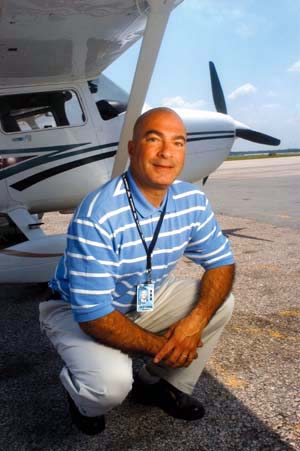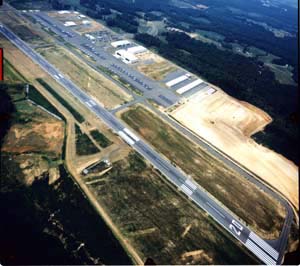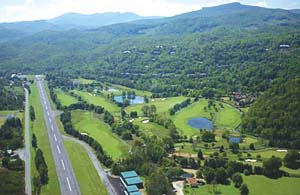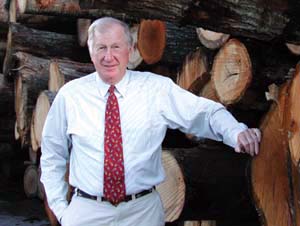
Cover
Story
Sky Kings
Chasing deals and serving far-flung clients
requires speed, which is why more business
people are taking to the clouds
By Lisa H. Towle
Learn More:
Why
It's a Pleasure to Fly on Business
New
Aviation Technology to Debut in North Carolina |
“Whenever
possible I fly, and that includes to meetings, It’s great when you can
do that because it means you can leave when you want, get to your
destination quickly, do your business and get home. You’re not stuck
in airports or in traffic, and you don’t have to spend the night
away.”
 Steve Zaytoun
(left), a Cary insurance broker Steve Zaytoun
(left), a Cary insurance broker

Concord Regional Airport, which many believe is
the best way to get to Charlotte, has grown into one of the business general
aviation airports in the U.S., with some 89,000 landings and takeoffs annually.

Land at Your Front Door: Your own
air strip is the hottest thing in amenities at upscale residential
developments, such as Elk River in the mountains, which also offers great
golf. |
 Paul
Barringer has spent the past 50 years with his head in the clouds, and it has
paid off big time for the chairman and CEO of Coastal Lumber Co. From his
headquarters in rural Weldon in Halifax County, Barringer has grown Coastal into
the largest exporter of hardwood lumber in the United States, with 34 mills
stretching from New York to Florida, Alabama to West Virginia. How does he
manage such a far-flung enterprise? He flies a lot, often at the controls of one
of the company’s three planes. Paul
Barringer has spent the past 50 years with his head in the clouds, and it has
paid off big time for the chairman and CEO of Coastal Lumber Co. From his
headquarters in rural Weldon in Halifax County, Barringer has grown Coastal into
the largest exporter of hardwood lumber in the United States, with 34 mills
stretching from New York to Florida, Alabama to West Virginia. How does he
manage such a far-flung enterprise? He flies a lot, often at the controls of one
of the company’s three planes.
“I built Coastal Lumber up by flying. We’ve grown primarily by using
aircraft to access growth opportunities and markets,” says Barringer (left)
. The joke
around the company is that the boss never buys a plant that doesn’t have air
access. Except it’s not really a joke.
Barringer’s formula for business success is elegant in its simplicity: Get
there first, get there fast. Many lumber mills are located in mountain or
coastal areas far off major roads. As soon as Coastal Lumber gets wind that a
mill they might be interested in is for sale, a company executive gets on a
company plane in a bid to be the first on the scene and so the first to seal the
deal. Likewise, if there are problems at a plant that need to be quickly
addressed or customers, bankers or insurers who need to be transported, the
planes and their professional, salaried flight crew — or Barringer himself —
are ready to takeoff.
“I believe in showing the flag,” says Barringer. “Management visits mills
every week. We can do this because we have one- or two-hour flights versus, say,
eight- or 10-hour drives.” Each airstrip with which Coastal does business
keeps a company car at the ready so its employees and associates don’t have to
worry about ground transportation.
It’s a winning strategy — Coastal Lumber’s annual sales exceed $350
million — though not an inexpensive one. The company’s lifeblood — its
three aircraft (prop jets and a smaller twin engine plane used to get into
smaller airstrips) — cost millions. Factor in hangar space and maintenance at
the base site, Halifax County Regional Airport in Roanoke Rapids, and soon
you’re talking about real money.
But it’s money well spent, says Barringer, “Once you analyze the
opportunities it (general aviation) presents — flexible scheduling, speedy
deals and problem resolution, tremendous customer service and marketing
advantages, among other things — the advantages come out to many times the
investment in the planes.”
Roger that, says 46-year old Steve Zaytoun, an aviation enthusiast since
childhood and a licensed pilot since 2000. “Whenever possible I fly, and that
includes to meetings,” explains Zaytoun, whose Cary-based insurance company,
Zaytoun & Associates Inc., has clients statewide. “It’s great when you
can do that because it means you can leave when you want, get to your
destination quickly, do your business and get home. You’re not stuck in
airports or in traffic, and you don’t have to spend the night away.”
The Sky’s the Limit
Business executives like Barringer and Zaytoun are the human faces behind
statistics showing a rapid rise in the number of pilots and the robust health of
the general aviation marketplace. At the end of April 2003, for instance, the
Aircraft Owners and Pilots Association (AOPA), the world’s largest civil
aviation organization, had nearly 400,000 members. That number has grown by
30,000 in the year and a half since the terrorist attacks on the United States.
The Federal Aviation Administration expects the U.S. pilot population to grow to
nearly 825,000 by 2011. With its 14,882 aviators, North Carolina ranks 13th
nationwide in the number of certificated pilots.
Another barometer of the health of general aviation is the increased activity in
North Carolina’s airport system, which has been evolving since the 1920s when
the General Assembly enacted the first statutes to guide airmen and local
governments in their aviation-related activities. Today, a network of 74
publicly owned airports, nine of which have airline service, means there’s an
airfield within 30 minutes of all population centers in the state.
While commercial air carriers have suffered mightily in the wake of 9/11,
general aviation —defined as all flying except that of the scheduled airlines
and military — has grown at a healthy clip. A measure of that growth can be
attributed to the terrorist attack backlash effect. The things that have always
made GA appealing — speed, flexibility and privacy — are even more
attractive to business people in the age of homeland security and consequent
disrupted schedules.
According to the AOPA, two-thirds of all GA flight hours involve business,
commercial, instructional and public service operations. The remainder of the
hours is devoted to personal travel. Further, an estimated 65 percent of general
aviation flights are conducted for business and public services that need
transportation more flexible than the airlines can offer.
The ripple effect of these airports is very real. Nationally, an immense fleet
of general aviation aircraft is the mainspring of a $20 billion a year industry
that generates more than $102 billion in economic activity. Becaue of how
information is reported, it’s difficult to calculate the financial impact of
GA within North Carolina. Given what is known, though, extrapolations can be
made. Ninety-five percent of the roughly 220,000 civil aircraft registered in
the U.S. are general aviation aircraft. There are 7,815 aircraft — general
aviation and otherwise — registered in the state (as opposed to aircraft based
in North Carolina, a larger number but harder to pinpoint). And aviation in
general contributes somewhere between $10 billion to $11 billion a year to the
state’s economy, says Bill Williams, director of the N.C. Department of
Transportation’s aviation division.
“No matter how you look at it,” adds Williams, “airports are definitely an
economic engine and tool for all regions in the state.… They make the country,
the world, a much smaller place.”
Business people like the fact that they can take advantage of rapid, on-demand
air transportation, he continues, and the air access helps attract corporations
that wouldn’t consider locating a plant, headquarters or distribution center
in an area without access to air transportation.
The Best Way to Charlotte
Access is a subject that comes up time and again when you ask business people
why they fly their own planes. Access also is the reason behind the stunning
growth of several regional airports across the state, which often are situated
close to major metro areas.
That’s why Concord Regional Airport — which didn’t even exist a decade ago
— has grown into one of the busiest general aviation airports in the United
States, with some 89,000 landings and takeoffs a year. Concord officials
actively promote their airport, which is located about 15 minutes from the
corner of Trade and Tryon, as the fastest way in and out of Charlotte.
Concord Regional also is minutes from Lowe’s Motor Speedway, the undisputed
epicenter of NASCAR, and its proximity to I-85 places it in the heart of the
highest growth corridor in North Carolina.
NASCAR is just one example of an industry that has heavily utilized general
aviation, and city officials actively encourage other businesses and industries
to follow its lead. A $13.3 million multi-phase, multi-year expansion program at
Concord Regional, whose centerpiece is a runway extension, signals they’re
making headway. The benefits of extending the runway by 1,900 feet are not just
improved safety and performance of planes but also the leverage Concord will
have when negotiating with potential customers.
Federal monies pay for the bulk of airport construction and their expansions.
Steve Merritt, an aviation program officer with the state’s aviation division,
says the funding breakdown is typically 80 percent federal, 10 percent state and
10 percent local. Maintenance expenses, like those for libraries and
recreational facilities, fall to local entities. “Those costs aren’t
considered an undue burden, though, because airports are viewed as assets,”
adds Merritt.
Lee County is a poster child for another aspect of general aviation: that having
a regional airport can be a key component in a local area’s economic
development infrastructure. Over the past two decades or so, Lee has progressed
from a grass airfield to a full-fledged airport. All that work and investment
paid off in October 2000 when the FAA determined that Raleigh-Durham
International needed relief from its traffic load. The all-new Sanford-Lee
County Regional was well positioned to take the overflow
Home to corporate aircraft, recreational aviators and an active flying club, the
airport, located on 700 acres within a half mile of U.S. 1, was built with 80
percent federal funds, 16 percent state funds and 4 percent local funds. It’s
valued at $9.5 million by the Lee County tax assessor, and brings the county and
the fire district in which it’s located more than $73,000 in combined real
estate taxes alone.
“The (personal) property tax on the (75 to 80) airplanes based at the airport
account for another big and direct financial benefit to Lee County, but the
transient planes, like the ones from Caterpillar or Wyeth that bring in
executives and freight, also contribute because they pay a 2 percent local sales
tax on fuel,” says Dan Swanson, manager of the airport, where a new corporate
hangar is rising for an undisclosed company in western Wake County that wants
ready access to its plants across North America.
The Multiplier Effect
And there’s something else that should be considered when factoring the impact
of GA on a region, says Tim Deike, director of Hickory Regional Airport. It’s
the multiplier affect. That is, what’s spent on meals, hotels and gasoline by
those who fly in to work or play.
While seeking to replace the commercial service it lost in April 2002 when US
Air withdrew from the market, Hickory Regional stays busy with the general
aviation needs of 11 counties whose combined populations total about 750,000.
Its primary users are some 100 corporate and private aircraft, tended by Profile
Aviation, the fixed base operator. In mid-July, Profile anticipates moving into
a new building complete with meeting facilities. Planning is under way for
extensive renovations to the passenger terminal, and negotiations are
progressing with a commuter airline to offer daily service to Raleigh-Durham
International.
On the table are several other ideas that will help Hickory Regional continue to
serve both the flying and non-flying public: Establishing a discount flight
service that would pull from the Charlotte market; building a hangar for N.C.
Forest Service aircraft used for forest fire operations; and developing a
facility for the display of vintage airplanes.
As reflected in Hickory’s plans, GA can be a critical part of other business
enterprises. They include aerial advertising; aerial surveying, exploration,
environmental surveys; agricultural application; business and corporate
transportation; emergency evacuations and rescue missions; fire spotting and
fire fighting; law enforcement; map making; medical transportation or emergency
flights; news reporting, photography, videotaping, and traffic monitoring;
on-demand air taxi service; overnight mail and package delivery; personal
transportation; pipeline and power line patrol.
Indeed, with about 95 percent of the civilian aircraft in the U.S. general
aviation planes and just 4 percent scheduled airliners, Hickory Regional’s
Deike never fails to be amazed that “when people think ‘transportation’ or
‘transportation and business’ they don’t automatically look to the sky.”
New
Aviation Technology to Debut in North Carolina
In a special edition of Time magazine devoted to the 100 people who most
influenced history over the past 100 years, Bill Gates, chairman and CEO of
Microsoft, wrote about Wilbur and Orville Wright. He said that powered flight
“… effectively became the World Wide Web of that era, bringing people,
languages, ideas and values together. It also ushered in an age of
globalization, as the world’s first flight paths became the superhighways of
an emerging international economy. Those superhighways of the sky not only
revolutionized international business; they also opened up isolated economies. .
. . ”
All that from little noticed but ultimately successful experiments that took
place on the isolated, windswept dunes of Kitty Hawk. Now in this the 100th
anniversary year of manned flight, North Carolina is on the brink of another
aviation first with far-reaching implications.
If all goes as planned, by the end of 2004 the state will be the first in the
lower 48 states to have installed statewide a new air safety technology known as
ADS-B. Tested in Alaska, ADS-B, which stands for automatic dependent
surveillance-broadcast, will provide pilots with real-time, graphic and textual
updates about traffic, weather and eventually even surrounding airspace. The
information will get from ADS-B ground stations to cockpits via Universal Access
Transceiver datalink technology.
In mid-May, North Carolina aviation officials, including state aviation director
Bill Williams, visited the Frederick, Md., headquarters of the Aircraft Owners
and Pilots Association to see the technology in action.
The AOPA, which has helped the Federal Aviation Administration develop the
technology, regards it as “part of the air traffic control system of the
future.” But, cautions Williams, a system can have little effect on air safety
unless pilots use it.
Sounds familiar, just as when, wrote Gates, “the Wright brothers gave us a
tool, but it was up to individuals and nations to put it to use. . . . ”
— Lisa H. Towle
 Why
It's a Pleasure to Fly on Business Why
It's a Pleasure to Fly on Business
Nov. 1, 1999, is a date etched into Steve Zaytoun’s memory. That’s when he
and a friend, Carl Ferland, owner of a dozen Denny’s franchises in North
Carolina and South Carolina, decided the time was right to explore their mutual
interest in aviation. They visited Southern Jet, a fixed base operator at
Raleigh-Durham International (RDU) that also offers flight training.
Ferland received his pilot certificate in September 2000 and Zaytoun (left), president
of Cary-based insurance brokerage firm Zaytoun & Associates, got his a month
later. Both men now own single engine planes that they keep at Southern Jet.
Zaytoun, who was taught by Steve Merritt, a pilot and certificated flight
instructor working out of RDU and the Johnston County Airport in Smithfield,
flies his Cessna about three times a week When asked is he flies mostly for
business or pleasure, he laughs and says, “They’re one in the same.”
That’s a common reaction, says Merritt, who also works as the WorldFlight 2003
coordinator for the state’s Division of Aviation. “Businesses may benefit
from the fact that the people who run them are pilots, but do those people learn
to fly for that reason? No. They do it because they want to fly, period.”
Two trends have come together to make it easier for business people to become
pilots. In the mid-1990s, thanks to a reform of aviation insurance laws, the
general aviation industry began pulling out of a slump it had been in throughout
the ’80s. With more favorable liability rules in place, manufacturers began
producing more aircraft.
And to ensure that there was a market for all these new planes in the market,
the aviation community launched the Be A Pilot program to teach people to fly.
Run by a coalition of the entire aviation community, Be A Pilot offers $49
introductory flight lessons through flight schools across the country, including
55 in North Carolina. The idea behind this, of course, is that once someone has
experienced flight from a cockpit they’ll never turn back. For the most part,
things have gone according to plan.
Zaytoun is one who never looked back after Nov. 1, 1999. He’s now working
toward his instrument rating so he can use cockpit instruments and won’t be
restricted to flying under visual flight rules. Next will come the commercial
designation. Some one-third of general aviation pilots who fly small planes hold
a commercial, rather than private, pilot certificate.
After that, well, the sky’s the limit. Zaytoun can see himself retired from
the insurance business, the owner of a twin-engine plane, flying charters to the
men’s NCAA Final Four basketball tournaments and to various tropical
destinations. — Lisa H. Towle
 |
Landing at
Your Front Door
Like avid golfers who choose to live on
a golf course, business
people who fly have
fueled the existence of 'fly-in communities'
A private
airstrip at Elk River is a popular amenity for homeowners at the
upscale Banner Elk country club |
Although
it helps, you don’t have to be rich to become a pilot and own your own small
plane. Heck, most pilots don’t even own the plane they fly. Most rent one by
the hour or share expenses with other pilots. In fact, according to the Be A
Pilot program, “many pilots spend as little as $1,500-$2,000 a year on flying
— what other people may spend on skiing, golf or other pursuits.”
Be that as it may, it does require disposable income to fly, and some pilots in
the higher tax brackets are at the forefront of a trend that marries air strips
and real estate. Like avid golfers who choose to live on a golf course, business
people who fly have fueled the existence of “fly-in communities.”
Indeed, North Carolina has a dozen or more such upscale developments that come
with private airstrips or airparks within an easy walk of your front door. The
list includes Aero Plantation in Weddington, Eagles Landing Airport in
Pittsboro, Elk River in Banner Elk, Goldhill Airpark in Goldhill, Lake Norman
Airpark in Mooresville, Long Island Airport in Terrell, Marchmont Plantation
Airport in Advance, Mountain Air in Burnsville, Pilot’s Ridge in Wilmington,
Seven Lakes in West End, Stag Air Park in Burgaw, and Tuckasegee Airpark in
Hayesville.
Steve Merritt of Wake County, a longtime pilot and certificated flight
instructor, is taking the concept of “fly-in communities” one step further.
He’s developed the idea of “hangar homes” for the Brunswick County
Airport, and is working through the approval process. What he’s proposed for
initial development is a 2,000-square-foot hangar topped by a 2,000-square-foot
home. Motor vehicles would also be parked under the residences.
Such hangar-home combinations exist elsewhere in the country, but not in North
Carolina. Anticipating questions, he’s quick to point out that the sound of
planes is music to the ears of pilots; that access to an airport would be
controlled either by card or keypad entry through a security gate; and that
regional airports, which grow quiet after darkness falls, would benefit from the
activity of residents.
Merritt estimates that the units would sell for $300,000 each. Quoted recently
in The State Port Pilot about the project, the airport manager Howie Franklin
called that amount the “low end” of a growing housing trend. -- Lisa H.
Towle
Return
to the magazine index
|